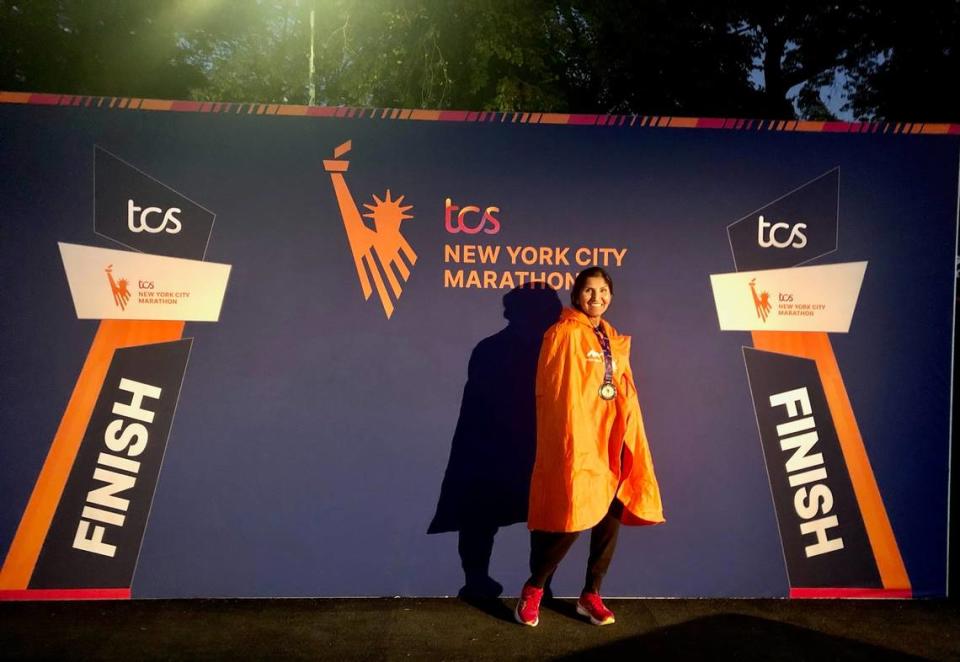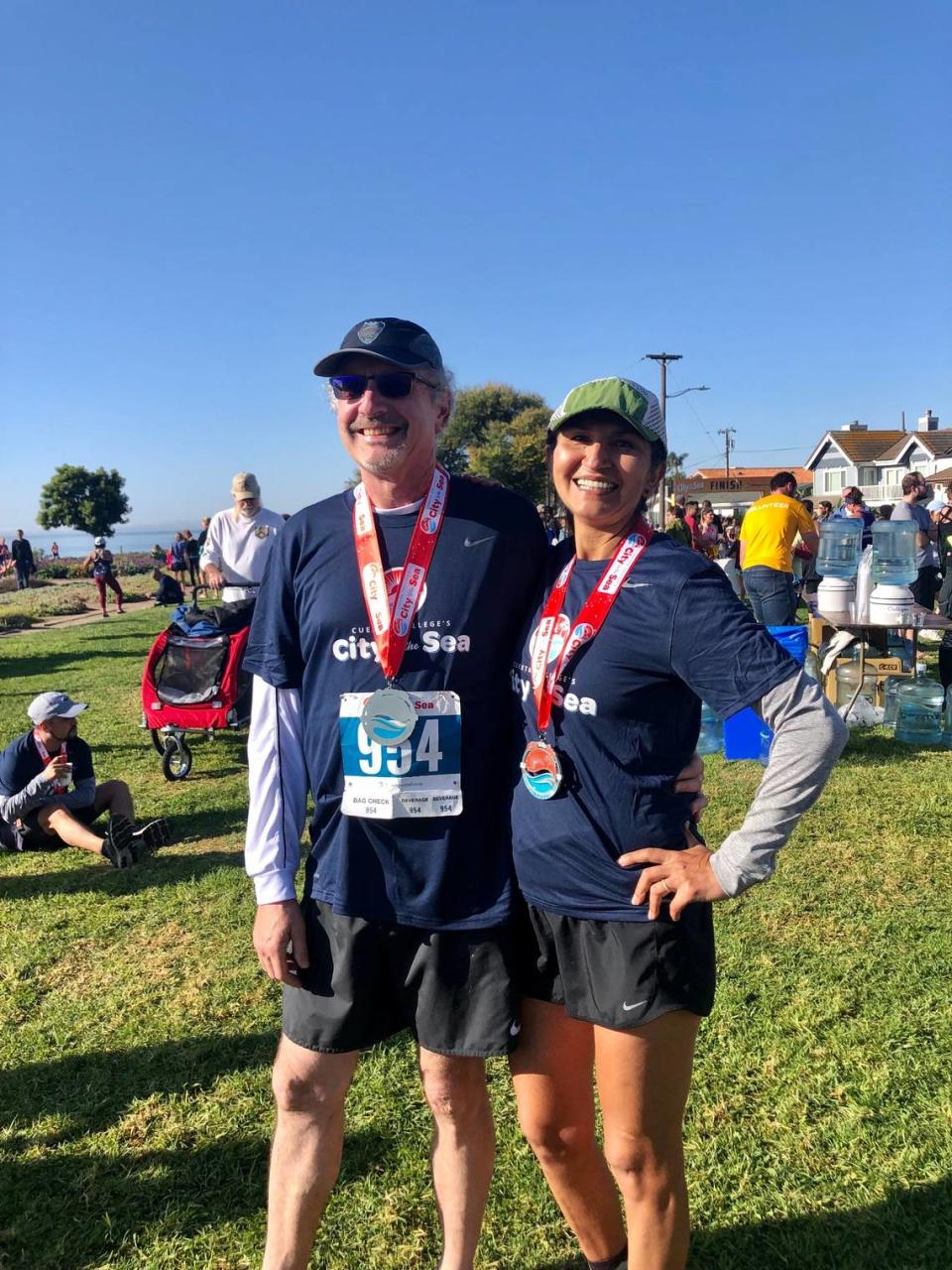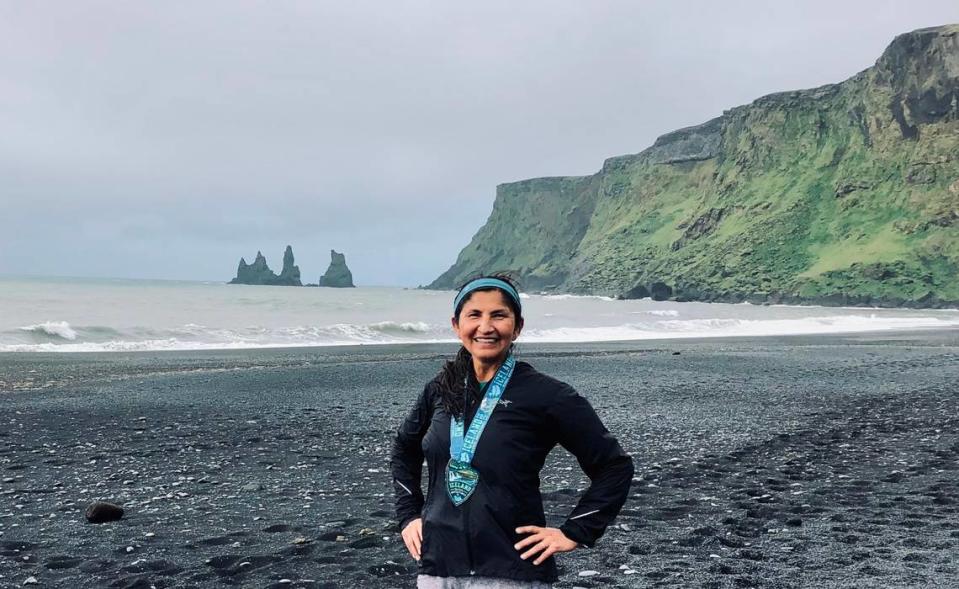Cal Poly professor, longtime SLO teacher runs in the New York City Marathon. ‘It’s a big goal’
After decades of training, a Cal Poly professor stood with a crowd of runners on the Verrazzano–Narrows Bridge in Staten Island — all poised to run the New York City Marathon on Nov. 5.
“All the ramps that go to the bridge are full of people,” Spanish professor Nelly Caminada said. “It’s a massive ocean, a moving wave of people.”
By 10:40 a.m., the race began, and the runners darted down the bridge like “one moving organism,” she said.
The 26.2-mile marathon started in Staten Island, looped through the five boroughs of New York City, and ended in Central Park.
Caminada, 58, joined about 50 other teachers sponsored by Tata Consultancy Services to run in the marathon.
“It’s sort of a bucket list marathon, the culmination of so many goals and preparation,” she told The Tribune in an interview after running in the event.
Her goal is to run in all six world major marathons — and she’s halfway there.
So far, she’s tackled the Boston, Chicago and New York City world marathon majors.
Next, she plans to run the London, Berlin and Tokyo marathons, she said.
“It’s a big goal,” Caminada said. “It keeps me present, keeps me alive, because I want to experience life with all the ups and downs.”

Training for the marathon
Caminada trained intensively for 16 weeks ahead of the marathon, but she’s been running for decades.
At 27, Caminada immigrated to the United States from Peru and enrolled at Allan Hancock College in Santa Maria. She played for the women’s national basketball team in Peru, but took up running in the United States instead of basketball while learning to speak English.
“With basketball, you have to communicate,” Caminada said. “You have to understand what the coach is saying and what the players need to do. I didn’t speak English in a way that I could understand what was going on. Running, it’s just you — you put one foot in front of the other.”
After earning her teaching credential from Chapman University and a masters degree from UC Santa Barbara, Caminada taught AP Spanish language and literature at San Luis Obispo High School for more than 20 years.
In San Luis Obispo, while teaching at the high school and raising a family, Caminada found a supportive community through running.
She found a group of other mothers and teachers who enjoyed trail running, too.
They trained together and entered races across the United States, including trails in the Grand Canyon in Arizona and the Rocky Mountains in Colorado, she said.

So far, Caminada has run in seven total marathons.
“If it wouldn’t have been for running, I probably would have been a little bit more of an isolated person,” she said. “I wouldn’t have met people that have the same lifestyle as mine.”
She also enjoys the way running makes her feel, she said.
“Running gives me the feeling of the present, the feeling that I’m here and now,” Caminada said. “I relax and I feel accomplished.”
Her years of running prepared her for how to train for the New York City Marathon, she said.
On the first Sunday of her 16-week training period, Caminada ran 10 miles. She then ran another 10 miles throughout that week.
By week 13, Caminada ran 20 miles on Sunday and another 22 miles during the rest of the week.
“People say: how can you do that? Isn’t that painful?,” Caminada said. “So I say, ‘yeah.’ You basically prepare for a decade to be able to run for four hours.”
During weeks 14, 15 and 16, she reduced the amount of miles she ran to allow her body to adjust to the training, she said.
“The muscle mass and the cardiovascular and the oxygen — all those adaptations that occur in the body start to actually settle, so you’re giving the body time to take all that in,” Caminada said. “When you approach the race, your body is ready for that kind of stress.”

Running through a roaring crowd
On Nov. 5, Caminada started her day at 3 a.m. with a bagel and peanut butter. She then boarded a bus at 5:30 a.m. to Staten Island: the starting point of the race.
By 10:40 a.m., Caminada and more than 51,000 runners darted down the Verrazzano–Narrows Bridge and crossed into Brooklyn. The crowd then ran north through the Williamsburg area to the Bronx, where they crossed another bridge to Manhattan. They then raced to Harlem, traveled down First Avenue and finished the marathon in Central Park.
As a teacher, Caminada was excited to see the locations of books she teaches to her students. But during the race, she most enjoyed the live music played by each borough — from a live rock band in Staten Island to a Gospel choir in Harlem.
“I was looking forward to seeing how each borough changes,” she said. “The music helped to see the differences.”
After running for about four hours, Caminada hit a challenging point during the race.
“I started to feel uncomfortable,” she said. “My legs were heavy, and I just had to do my mantras.
She would tell herself, “I trained for this.” Then, “left foot, right foot.”
One major idea got her through the end of the race: “Pain is temporary, at some point it ends. But pride is forever,” she said.
She said her experiences as an immigrant, a parent and a teacher taught her a mindset of resilience.
“I was just learning to be comfortable with what is uncomfortable,” Caminada said. “Day by day you learn that.”
Near the end of the marathon, people lined the streets of First Avenue to cheer the runners on.
“That pumps you up,” Caminada said.
Caminada finished the race in 4 hours, 39 minutes and 19 seconds.
“You see the 800 meters to the finish line and think, ‘I can do this, I can do this,’” Caminada said. “It is so cool to feel that way.”

